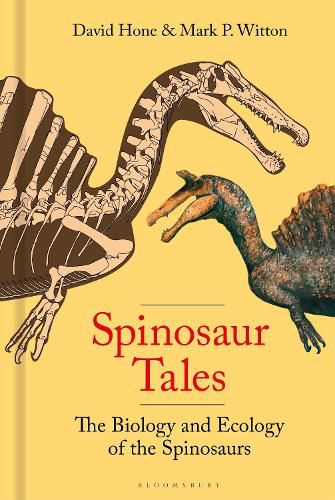Readings Newsletter
Become a Readings Member to make your shopping experience even easier.
Sign in or sign up for free!
You’re not far away from qualifying for FREE standard shipping within Australia
You’ve qualified for FREE standard shipping within Australia
The cart is loading…






The spinosaurs - the dinosaur group that includes the largest land predator of all time, the awe-inspiring Spinosaurus - star in this cutting-edge review.
The giant sail-backed carnivorous dinosaur Spinosaurus is one of the most famous of all dinosaurs; a staple of documentaries, books and video games, and the beast that bested the mighty Tyrannosaurus rex in Jurassic Park III. But what do we actually know about this crocodile-headed monster and its relatives, the spinosaurs?
The spinosaurs were some of the strangest predatory dinosaurs, combining a long low skull with powerfully clawed hands. Some species had huge sails over their backs, as well as fin-like tails. A great deal of scientific mystery surrounds them. Their fossil remains are highly fragmentary, many aspects of their appearance uncertain, their evolutionary relationships elusive, and interpretations of their ecology and behaviour are hotly contested.
Spinosaur Tales explores the exciting, sometimes controversial world of spinosaur science. Bringing these creatures back to life with stunning illustrations, world-renowned palaeontologists David Hone and Mark P. Witton present the latest views on the evolution, anatomy and lifestyles of an enigmatic yet charismatic dinosaur group.
$9.00 standard shipping within Australia
FREE standard shipping within Australia for orders over $100.00
Express & International shipping calculated at checkout
Stock availability can be subject to change without notice. We recommend calling the shop or contacting our online team to check availability of low stock items. Please see our Shopping Online page for more details.
The spinosaurs - the dinosaur group that includes the largest land predator of all time, the awe-inspiring Spinosaurus - star in this cutting-edge review.
The giant sail-backed carnivorous dinosaur Spinosaurus is one of the most famous of all dinosaurs; a staple of documentaries, books and video games, and the beast that bested the mighty Tyrannosaurus rex in Jurassic Park III. But what do we actually know about this crocodile-headed monster and its relatives, the spinosaurs?
The spinosaurs were some of the strangest predatory dinosaurs, combining a long low skull with powerfully clawed hands. Some species had huge sails over their backs, as well as fin-like tails. A great deal of scientific mystery surrounds them. Their fossil remains are highly fragmentary, many aspects of their appearance uncertain, their evolutionary relationships elusive, and interpretations of their ecology and behaviour are hotly contested.
Spinosaur Tales explores the exciting, sometimes controversial world of spinosaur science. Bringing these creatures back to life with stunning illustrations, world-renowned palaeontologists David Hone and Mark P. Witton present the latest views on the evolution, anatomy and lifestyles of an enigmatic yet charismatic dinosaur group.